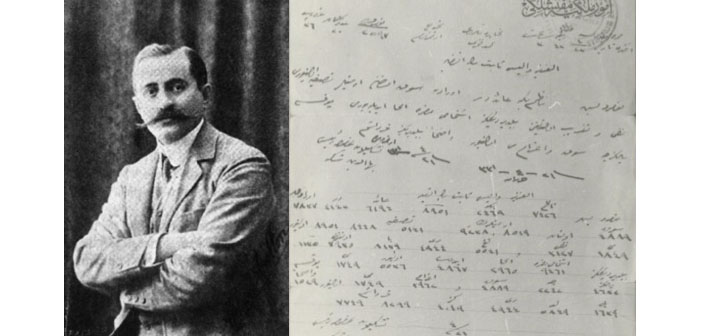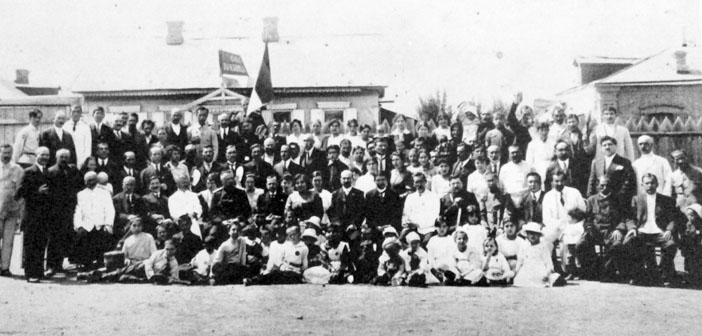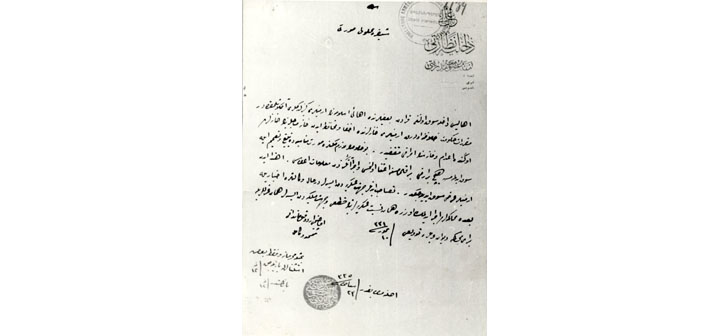Historian Taner Akçam decpihred the telegram by executive of Teşikilat-ı Mahsusa (Secret Organization) and Commitee of Union and Progress Bahaettin Şakir dated July 4, 1915. The telegram is about coordination of deportation and annihilation of Armenians. The letterhead on the telegram proves that it is indeed original.
We
have a telegram written by Bahaettin Şakir on July 4, 1915, which
was sent to Governor Sabit Bey for delivering it to Elağız
(Harput/Kharpet) Inspector of CUP Nazım Bey. The purpose of the
telegram was to coordinate deportation and annihilation of
Armenians. The telegram reads: “Are the Armenians who were deported
from there being evacuated? Are the troublesome individuals whom you
have reported as being exiled are being annihilated or merely sent
off and deported? Please report back honestly."
Pay attention to the letterhead!
On the upper right corner of the telegram, there is the original letterhead of Ministry of Interior. The text is coded in Arabic lettering; four-digit numbers denoted words. On the top of these four-digit numbers, words or affixes are noted. The letterhead on the telegram proves that it is indeed original.
In fact, researchers and people interested in this issue have known about the content of this document before; so, this is not an unknown or newly discovered document. In order to understand the document and its content better, we have to mention Bahaettin Şakir's personality, duties and responsibilities.
Who is Şakir?
Bahaettin Şakir was a member of CUP and one of the chief executives of Teşkilat-ı Mahsusa. Before Ottomans went to war officially, Şakir was sent to Erzurum (August 1914) in order to carry out the activities of Teşkilat-ı Mahsusa. His main duty was to organize Muslim revolts in Caucasus. We have a lot of Ottoman documents showing that Şakir was coordinating the activities of Teşkilat-ı Mahsusa in the region. All these documents can be found in Ottoman archives. Some documents mention him directly as “Erzurum official of Teşkilat-ı Mahsusa”. After Caucasus campaigns failed, Şakir completely focused on annihilation of Armenians. He had a car and was using the codes of ministries of interior and defense.
After the war, between 1919 and 1921, Şakir was tried as part of the cases against executives of CUP in Istanbul. He was a suspect both in the “main case” of CUP executives and “Mamüretülaziz (Elazığ-Harput)" case. Şakir was sentenced to death in his absence in Mamüretülaziz case.
Criminal evidence
The telegram dated July 4, 1915 was one of the most important evidences in this case. In the indictments of main case and Mamüretülaziz case, this document was referred and quoted. In the indictment of main case, the prosecution fully quoted the telegram and defined it as a “coded telegram”. It was stated that the “image” of the telegram was in the file.
According to the indictment, Istanbul-based Teşkilat-ı Mahsus gave Bahaettin Şakir a considerable amount of money, explosives and a car, as well as encryption key for using confidential correspondences before he went to Erzurum. Governor of Erzurum Tahsin Bey also confirmed that one of the keys belonged to ministry of interior. Heard as a witness in Mamüretülaziz case, Tahsin Bey stated that “Bahaettin Şakir had two encryption keys for communicating with Bab-ı Ali (Sublime Porte) and ministry of war”. The telegram was read during the hearing on January 10, 1920.
Given these facts, the document we have is not unknown. The letterhead showing that it belonged to ministry of interior is original. However, we found another information that also proves the originality of this telegram.
Code of the document
As you can see in the picture below, the document consists of four-digit numbers. This is the coded version of the text. Deciphered words are written on top of the related groups of numbers.
In Ottoman archive, there are lots of coded documents belonging to ministry of interior, most of which are telegrams from other provinces to Istanbul. A considerable amount of telegrams dated July 1915 were written in four-digit numbers. In these telegrams with four-digit numbers, 9 different types of coding were used. Generally, the type of coding used in the telegram was noted at the beginning of the telegram. As noted in the telegram, Bahaettin Şakir was used the coding number 5.
We compared Şakir's telegram to other documents from the archive that were coded with number five and written with four-digit numbers. Comparison is very easy, since deciphered words were written on the documents. As a result of this comparison, we revealed an important fact: Bahaettin Şakir used the encryption key no. 5 which belonged to ministry of interior. In 25 telegrams we checked, we determined that words and suffixes used in Şakir's telegram were used 34 times. Words and suffixes we identified and the groups of numbers denoting them are as follows:
Sevk (send off) [4889]: 18 documents;
Yalnız (merely) [4632]: 3 documents;
Bey [2469]: 5 documents;
leri [plural suffix- 9338]: 3 documents
Oradan (there) [7837]: 1 document;
İzam (exaggeration) [3962]: 1 document
Kardaş (brother) [8299]: 1 document;
im/ım eki [first person possesive suffix: 7749]: 1 document;
Ermeni (Armenian) (8519): 1 document.
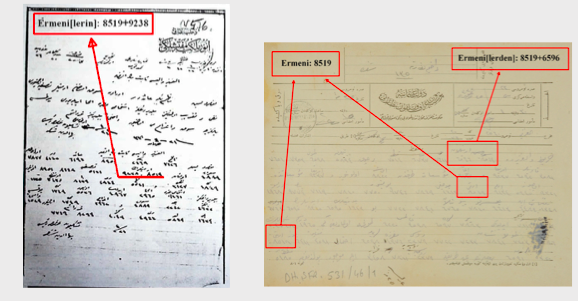
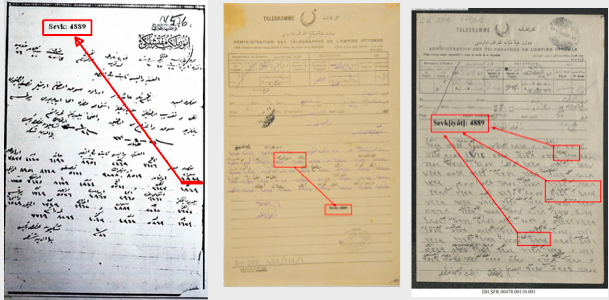
There is another important point we should note: these documents we have found in Ottoman archive were opened to researchers by 2010. Thus, before 2010, nobody knew about these codes.
The document is certainly original. And this document clearly shows that CUP executives subjected Armenians to a systematic annihilation. It's about time ending denialism which causes nothing but more and more harm!


